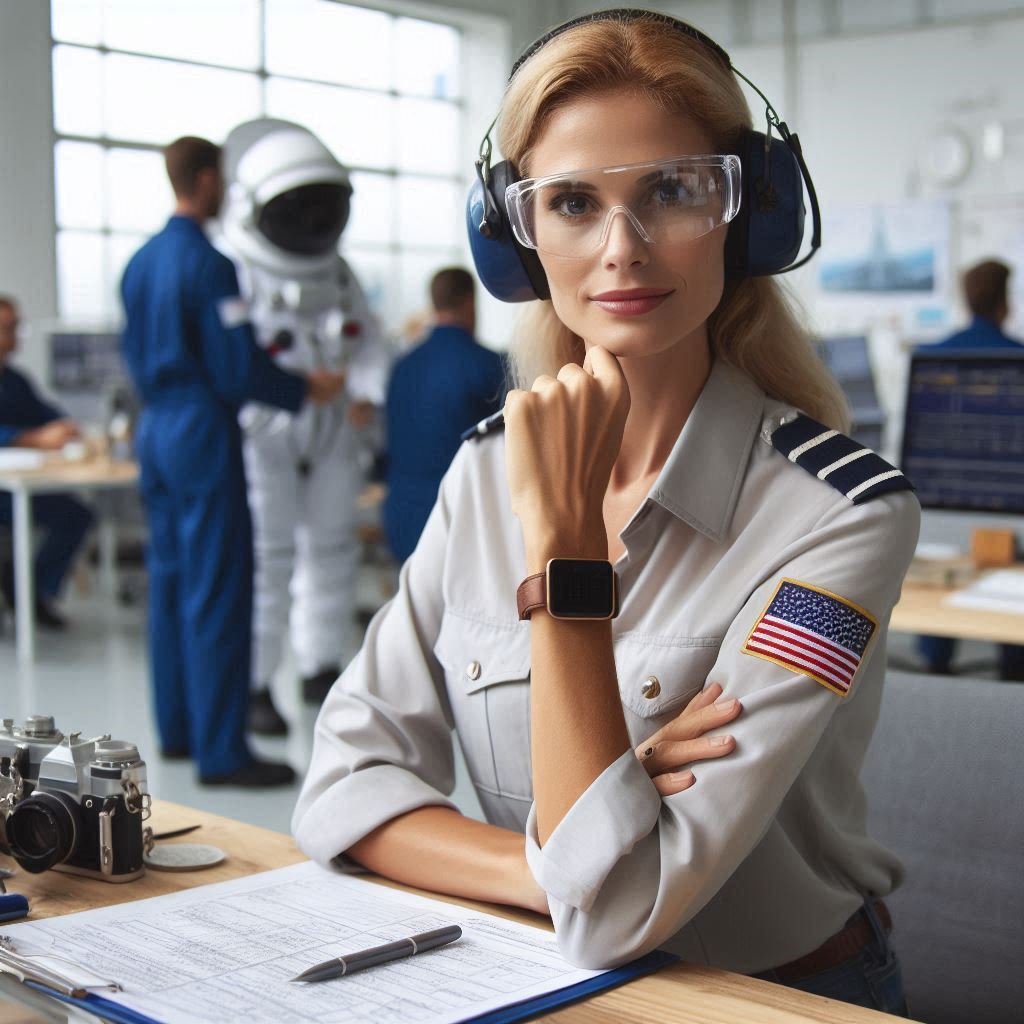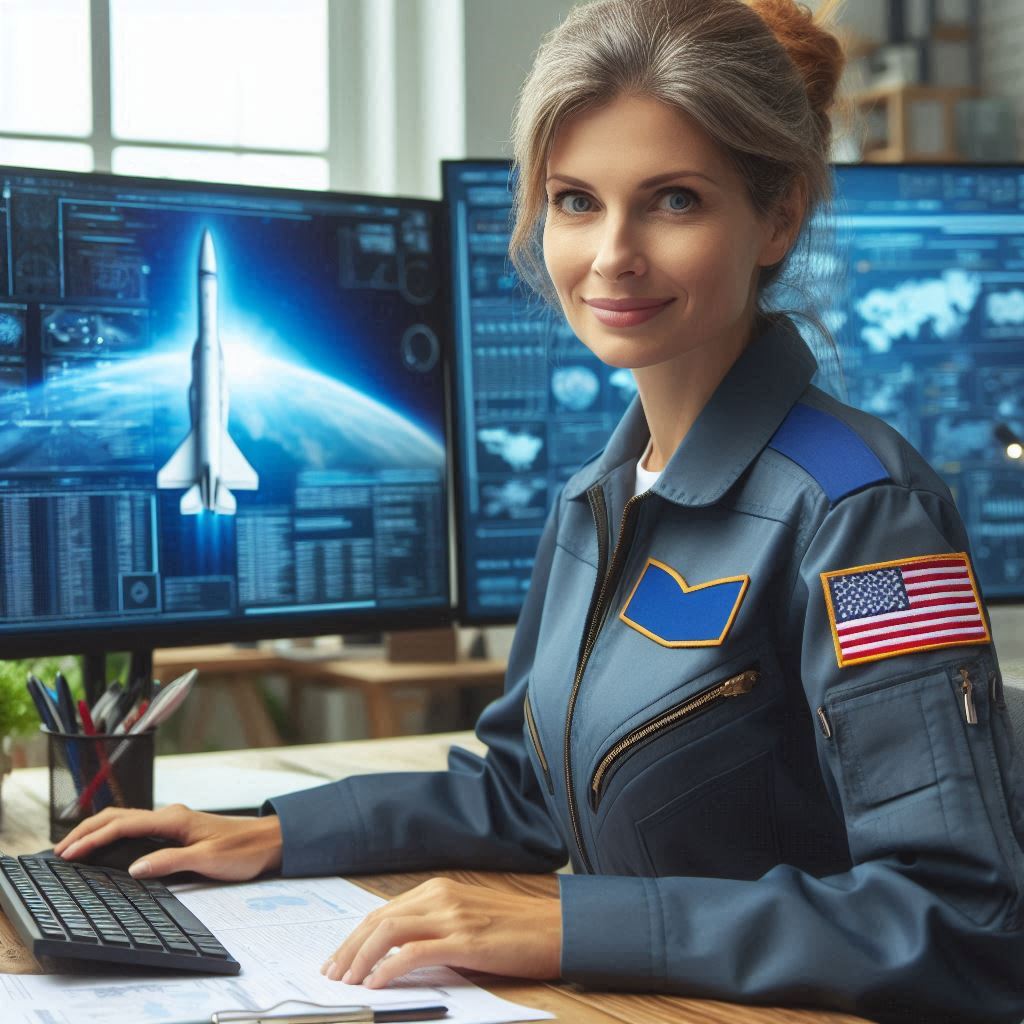Introduction
Artificial Intelligence (AI) encompasses a range of technologies that enable machines to perform tasks requiring human-like intelligence.
These tasks include learning from data, reasoning, making decisions, and solving complex problems.
AI systems use algorithms and data to mimic human cognitive functions, such as visual perception, language understanding, and problem-solving abilities.
Aerospace engineering is a specialized field focused on the design, development, and maintenance of aircraft and spacecraft.
It combines principles from various disciplines, including aerodynamics, propulsion, avionics, and structural analysis, to create and optimize vehicles that operate in the atmosphere and outer space.
The integration of AI into aerospace engineering is transforming the industry in profound ways.
AI technologies enhance the efficiency and effectiveness of design processes, enable smarter flight controls, and improve predictive maintenance.
By leveraging AI, aerospace engineers can analyze vast amounts of data to optimize performance, enhance safety, and reduce operational costs.
The impact of AI in aerospace engineering promises to drive significant advancements and innovations, reshaping how the industry approaches design, development, and operational challenges.
Brief history of AI in the aerospace industry
Early Use of AI in Aerospace Engineering
Artificial Intelligence (AI) began influencing aerospace engineering in the 1980s.
Early applications focused on improving design and simulation processes.
Engineers used AI to optimize aircraft and spacecraft designs.
AI algorithms helped in predicting performance and identifying potential issues.
In the 1990s, AI technologies advanced, integrating machine learning into aerospace engineering.
Researchers developed algorithms for flight control systems and navigation aids.
These systems enhanced the precision and reliability of aircraft operations.
AI tools began analyzing vast amounts of data to improve decision-making processes.
The 2000s marked a significant leap in AI’s role within aerospace engineering.
Companies started employing AI for real-time systems monitoring and diagnostics.
AI systems helped in predictive maintenance, reducing downtime and improving safety.
Automated systems began assisting in complex mission planning and execution.
Key Milestones and Advancements
A significant milestone in AI’s impact on aerospace engineering occurred in the early 2010s.
The development of advanced machine learning algorithms enabled more sophisticated data analysis.
These algorithms improved aircraft design, making it more efficient and reliable.
In 2014, AI played a critical role in NASA‘s Mars Rover missions.
AI systems helped navigate the rover and analyze Martian terrain.
These systems allowed for autonomous decision-making in challenging environments, showcasing AI’s potential in space exploration.
The launch of autonomous drones represents another key advancement.
By 2016, AI-powered drones began performing complex tasks, including surveillance and delivery.
These drones used AI to navigate, avoid obstacles, and complete missions with high accuracy.
The integration of AI in predictive maintenance systems is another notable milestone.
In the late 2010s, aerospace companies started using AI to predict component failures.
These systems analyze operational data to forecast maintenance needs, improving safety and reducing costs.
AI also revolutionized aircraft design with the advent of generative design algorithms.
These algorithms create optimized designs by exploring numerous variables and constraints.
In 2018, Airbus used AI to develop a more efficient wing design, highlighting the technology‘s impact on innovation.
Another recent advancement is the use of AI in enhancing flight safety systems.
AI-driven systems now assist in collision avoidance and emergency response.
These systems process real-time data to provide timely alerts and recommendations to pilots.
Therefore, AI‘s early use in aerospace engineering focused on design optimization and simulation.
Over the decades, AI advancements led to significant milestones, including autonomous systems, predictive maintenance, and improved safety features.
From Mars Rover missions to autonomous drones, AI continues to transform aerospace engineering, driving innovation and enhancing performance.
As AI technology evolves, its impact on aerospace engineering will likely grow even more profound, shaping the future of the industry.
Applications of AI in Aerospace Engineering
AI in Aircraft Design and Development
AI plays a pivotal role in aircraft design and development.
Engineers use AI algorithms to optimize designs and improve performance.
Machine learning models analyze vast datasets to predict aerodynamic properties and structural strengths.
This analysis speeds up the design process and enhances accuracy.
Generative design is a key AI application.
It allows engineers to input performance criteria and let AI generate optimal design solutions.
This method results in lighter, stronger, and more efficient aircraft components.
AI also aids in material selection, predicting how different materials will perform under various conditions.
Simulation and modeling benefit greatly from AI.
AI-driven simulations test multiple design scenarios quickly and accurately.
Engineers use these simulations to refine designs before physical prototypes are built.
This reduces development time and costs, leading to more innovative aircraft designs.
AI in Improving Flight Safety and Efficiency
Firstly, AI enhances flight safety by providing real-time monitoring and predictive maintenance.
AI systems analyze data from aircraft sensors to detect potential issues before they become critical.
Predictive algorithms forecast maintenance needs, reducing unexpected failures and improving safety.
AI improves flight efficiency through optimized flight planning and route management.
Algorithms process weather data, air traffic information, and aircraft performance to suggest the most efficient flight paths.
This optimization reduces fuel consumption, minimizes delays, and enhances overall operational efficiency.
Autonomous systems and AI-powered cockpit technologies contribute to safer and more efficient flying.
Advanced autopilot systems use AI to assist pilots in navigating complex situations.
These systems can manage routine tasks, allowing pilots to focus on critical decision-making.
AI also aids in real-time decision support during flights.
AI systems analyze incoming data from various sources to provide actionable insights.
This support helps pilots make informed decisions quickly, improving safety and operational efficiency.
Furthermore, AI-driven analytics support flight operations by optimizing scheduling and crew management.
Predictive analytics forecast demand, enabling airlines to adjust schedules and staffing levels accordingly.
This results in better resource utilization and enhanced operational efficiency.
In fact, AI significantly impacts aerospace engineering by transforming aircraft design and development.
Its applications improve safety, efficiency, and innovation in the industry.
AI technologies enable more precise designs, predictive maintenance, and optimized flight operations.
As AI continues to advance, it will further enhance the capabilities and safety of modern aerospace engineering.
Embracing AI technologies is essential for staying competitive and advancing in the aerospace sector.
Transform Your Career Today
Unlock a personalized career strategy that drives real results. Get tailored advice and a roadmap designed just for you.
Start NowRead: Economic Indicators and Their Influence on US Architects
Advantages of using AI in aerospace engineering
Increased Accuracy and Precision in Design and Maintenance
Artificial Intelligence (AI) revolutionizes aerospace engineering by enhancing design and maintenance accuracy.
AI algorithms analyze vast amounts of data quickly and accurately.
This capability leads to more precise design specifications and improved engineering outcomes.
Engineers use AI-driven tools to create detailed simulations and models.
These tools predict how designs will perform under various conditions, reducing the likelihood of errors.
In maintenance, AI predicts equipment failures before they occur.
By analyzing historical data and real-time inputs, AI identifies potential issues early.
This predictive maintenance prevents costly repairs and extends the lifespan of aerospace components.
Enhanced Decision-Making Capabilities
AI significantly boosts decision-making capabilities in aerospace engineering.
Advanced AI systems process complex data sets and provide actionable insights.
Engineers and managers can make informed decisions based on AI-generated predictions and analyses.
AI tools evaluate multiple scenarios and recommend optimal solutions quickly.
For example, AI can assess various design alternatives and suggest the most efficient option.
This ability speeds up the decision-making process and improves project outcomes.
In mission planning, AI analyzes vast amounts of information to optimize routes and strategies.
This enhances the effectiveness and efficiency of aerospace missions.
Reduction in Human Errors and Operational Costs
AI helps reduce human errors and operational costs in aerospace engineering.
Automation of routine tasks minimizes the risk of mistakes caused by human oversight.
AI systems perform repetitive and precise tasks consistently without fatigue.
This automation improves overall accuracy and reliability in engineering processes.
Additionally, AI reduces operational costs by optimizing resource usage and improving efficiency.
For example, AI-driven systems optimize fuel consumption in aircraft, leading to cost savings.
AI also enhances supply chain management by predicting demand and managing inventory effectively.
These efficiencies translate to lower operational costs and better resource allocation.
Essentially, AI‘s impact on aerospace engineering is profound and multifaceted.
It increases accuracy and precision in design and maintenance, enhancing overall engineering outcomes.
AI‘s enhanced decision-making capabilities enable more informed and efficient project management.
Furthermore, AI reduces human errors and operational costs through automation and optimization.
Embracing AI technologies leads to significant advancements in aerospace engineering, driving innovation and improving operational efficiency.
Read: Post-Pandemic Design Trends: US Architects Adapt
Challenges Faced in Implementing AI in Aerospace Engineering
Implementing AI in aerospace engineering poses several challenges that need to be addressed to ensure the successful integration of this technology into the industry.
These challenges range from ethical concerns to the need for skilled professionals to work with AI technology and regulatory hurdles that must be overcome to ensure safety and compliance.
Ethical concerns regarding AI decision-making
One of the main challenges in implementing AI in aerospace engineering is the ethical concerns regarding decision-making.
AI systems rely on algorithms and machine learning to make complex decisions, which can raise questions about accountability and transparency in decision-making processes.
There is a need to establish guidelines and ethical frameworks to ensure that AI systems in aerospace engineering adhere to ethical standards and do not compromise safety or security.
Need for skilled professionals to work with AI technology
Another challenge is the need for skilled professionals to work with AI technology in the aerospace industry.
As AI continues to evolve and become more advanced, there is a growing demand for professionals with specialized skills in AI and machine learning.
Aerospace engineering firms need to invest in training and development programs to upskill their workforce and ensure they have the expertise needed to work effectively with AI technology.
Regulatory hurdles and safety concerns
Regulatory hurdles and safety concerns are also significant challenges in implementing AI in aerospace engineering.
The aerospace industry is highly regulated, with strict safety standards that must be adhered to in aircraft design and operation.
AI introduces new complexities and uncertainties that need to be addressed to ensure that safety standards are maintained.
Regulatory bodies need to develop guidelines and frameworks for the safe implementation of AI in aerospace engineering to mitigate risks and ensure compliance with industry regulations.
In essence, implementing AI in aerospace engineering presents a range of challenges that need to be addressed to ensure the successful integration of this technology into the industry.
By addressing ethical concerns, investing in training and development programs for professionals, and navigating regulatory hurdles, aerospace engineering firms can harness the full potential of AI technology to drive innovation and efficiency in the industry.
Read: Impact of Local Building Codes on US Architecture.
Impact of AI on the future of aerospace engineering
Predictions On How Ai Will Shape The Future Of Aircraft Design And Performance
Artificial Intelligence (AI) is revolutionizing the field of aerospace engineering in ways that were once thought to be science fiction.
The integration of AI into aircraft design and operation is leading to cutting-edge advancements that are reshaping the future of aerospace engineering.
AI-driven Aircraft Design
AI algorithms are being used to optimize every aspect of aircraft design, from aerodynamics to materials.
These algorithms can analyze vast amounts of data and simulate different scenarios to create highly efficient and innovative aircraft designs.
This leads to reduced fuel consumption, better performance, and improved safety standards.
One of the key benefits of AI-driven aircraft design is the ability to quickly iterate and test new ideas.
This means that engineers can explore a wider range of design possibilities without the traditional constraints of time and resources.
As a result, we are seeing a rapid acceleration in the development of next-generation aircraft that are more efficient, eco-friendly, and cost-effective.
AI-enabled Aircraft Performance
AI is also playing a crucial role in enhancing aircraft performance.
Through predictive maintenance algorithms, AI can analyze real-time data from sensors installed on aircraft components to predict when maintenance is required.
This proactive approach helps to prevent unexpected breakdowns, reduce downtime, and ultimately improve the reliability and safety of aircraft operations.
Furthermore, AI is being used to optimize flight paths, reduce fuel consumption, and enhance overall flight efficiency.
By analyzing weather patterns, air traffic, and other variables in real-time, AI algorithms can make decisions that result in smoother, more efficient flights.
This not only benefits airlines by reducing operating costs but also minimizes the environmental impact of air travel.
Potential Advancements In Autonomous Aircraft And Space Exploration
Autonomous Aircraft and Space Exploration
AI is driving advancements in autonomous aircraft technology, paving the way for fully autonomous flights in the near future.
These aircraft can take off, navigate, and land without human intervention, opening up new possibilities for air transportation and cargo delivery.
The use of AI in autonomous aircraft also has implications for space exploration, as it enables more precise and efficient control of spacecraft.
Space agencies and private companies are increasingly turning to AI technologies to enhance their missions and push the boundaries of space exploration.
AI-powered systems are being used to analyze vast amounts of data collected from satellites, rovers, and spacecraft, helping scientists to make discoveries and advancements in our understanding of the universe.
Showcase Your Business Today
Reach thousands of readers actively exploring professional services. Publish your business profile and grow your audience now.
Publish NowSafety and Reliability
One of the main concerns in aerospace engineering is ensuring the safety and reliability of aircraft.
AI plays a crucial role in achieving this goal by improving predictive maintenance, optimizing flight operations, and enhancing decision-making processes.
By leveraging AI technologies, aerospace engineers can proactively identify potential risks and take preventive measures to ensure the safety of passengers and crew.
AI also enables real-time monitoring of aircraft systems, allowing for early detection of anomalies and malfunctions.
This proactive approach reduces the likelihood of in-flight emergencies and ensures that aircraft operations are smooth and reliable.
As AI continues to evolve, we can expect even greater advancements in safety and reliability in the aerospace industry.
The impact of AI on the future of aerospace engineering is undeniable.
From revolutionizing aircraft design to enabling autonomous flights and advancing space exploration, AI is reshaping the way we think about aerospace technology.
As AI technologies continue to evolve, we can expect even more exciting developments that will push the boundaries of what is possible in the field of aerospace engineering.
Read: How to Become a Civil Rights Advocate

Gain More Insights: Women in Agricultural Engineering: Success Stories
Explore Further: Top Training Programs for Industrial Machinery Mechanics
You Might Also Like: Future of Biomedical Equipment Technician Profession
Uncover the Details: Sustainable Systems Engineering Practices and Principles
Learn More: How to Advance in Your Computer Engineering Career
Collaborations between AI experts and aerospace engineers
Collaboration between AI experts and aerospace engineers is crucial for tapping into the full potential of AI technology in the aerospace industry.
This interdisciplinary collaboration brings together the expertise of AI specialists in developing advanced algorithms and machine learning models with the knowledge of aerospace engineers in designing and optimizing aircraft systems.
By working together, AI experts can help aerospace engineers analyze vast amounts of data collected from sensors and aircraft systems to improve safety, efficiency, and performance.
On the other hand, aerospace engineers can provide valuable insights into the specific challenges and requirements of the aerospace industry to guide the development of AI solutions.
Importance of interdisciplinary collaboration in leveraging AI technology
- Enhanced problem-solving capabilities: AI experts and aerospace engineers can combine their skills to tackle complex problems that require a combination of technical knowledge and domain expertise.
- Accelerated innovation: Collaborations between AI experts and aerospace engineers can lead to the rapid development of cutting-edge technologies and solutions that drive innovation in the aerospace industry.
- Optimized decision-making processes: By leveraging AI technology, aerospace engineers can make more informed decisions based on real-time data analysis and predictive modeling, leading to improved operational efficiency and safety.
- Improved system performance: AI-based solutions can enhance the performance of aircraft systems by predicting potential failures, optimizing maintenance schedules, and reducing downtime.
Examples of successful partnerships in the aerospace industry
Boeing and SparkCognition
Boeing, a leading aerospace manufacturer, collaborated with AI startup SparkCognition to develop a predictive maintenance solution for its aircraft fleet.
By analyzing sensor data in real-time, the AI system can detect potential maintenance issues before they occur, reducing downtime and maintenance costs.
Airbus and Neurala
Airbus partnered with AI technology company Neurala to deploy deep learning algorithms for inspecting aircraft components using drones.
The AI system can autonomously identify defects in aircraft structures, improving quality control processes and ensuring safety standards are met.
NASA and Google
NASA teamed up with Google to apply machine learning algorithms to analyze satellite images and sensor data for monitoring weather patterns, tracking environmental changes, and predicting natural disasters.
This collaboration has enhanced NASA’s capabilities in earth observation and climate research.
Lockheed Martin and NVIDIA
Lockheed Martin, a global aerospace and defense company, joined forces with NVIDIA to leverage GPU technology for accelerating simulations and modeling of aircraft systems.
The partnership has enabled Lockheed Martin to improve the performance and efficiency of its aircraft design processes.
This demonstrates the significant impact that collaborations between AI experts and aerospace engineers can have on advancing technology, improving safety, and driving innovation in the aerospace industry.
Moving forward, continued partnership and knowledge-sharing between these two disciplines will be vital for unlocking the full potential of AI in aerospace engineering.
Overall, the synergy between AI technology and aerospace engineering holds great promise for revolutionizing the way aircraft are designed, operated, and maintained in the future.
By harnessing the power of AI through interdisciplinary collaborations, the aerospace industry can achieve new levels of efficiency, safety, and performance that were previously unimaginable.
Conclusion
Artificial Intelligence (AI) plays a crucial role in transforming aerospace engineering.
Its integration enhances various aspects of the field, including design, operational efficiency, and safety.
AI technologies optimize flight controls, enabling more precise and adaptive responses to changing conditions.
They also facilitate predictive maintenance, which helps identify potential issues before they become critical, thus reducing downtime and maintenance costs.
The benefits of incorporating AI into aerospace engineering are significant.
AI improves overall performance, reduces operational costs, and enhances safety protocols.
By analyzing vast amounts of data, AI systems can provide insights that lead to more innovative solutions and streamlined processes.
However, integrating AI into aerospace engineering also presents challenges.
Ensuring system reliability and addressing ethical concerns related to decision-making algorithms are critical considerations.
Continued research and innovation are essential to address these challenges and unlock AI’s full potential in aerospace.
The industry must invest in developing advanced AI technologies and refining existing systems.
Engineers, researchers, and industry leaders should collaborate to explore new AI applications and improve current technologies.
By embracing AI‘s potential, the aerospace sector can achieve unprecedented advancements and efficiency.
[E-Books for Sale]
The Big Book of 500 High-Paying Jobs in America: Unlock Your Earning Potential
$19.99 • 500 High-Paying Jobs • 330 pages
Explore 500 high-paying jobs in America and learn how to boost your career, earn more, and achieve success!
See All 500 High-Paying Jobs of this E-Book
1001 Professions Without a Degree: High-Paying American Jobs You Can Start Now
$19.99 • 1001 Professions Without a Degree • 174 pages
Discover 1001 high-paying jobs without a degree! Unlock career tips, skills, and success strategies for just $19.99!




